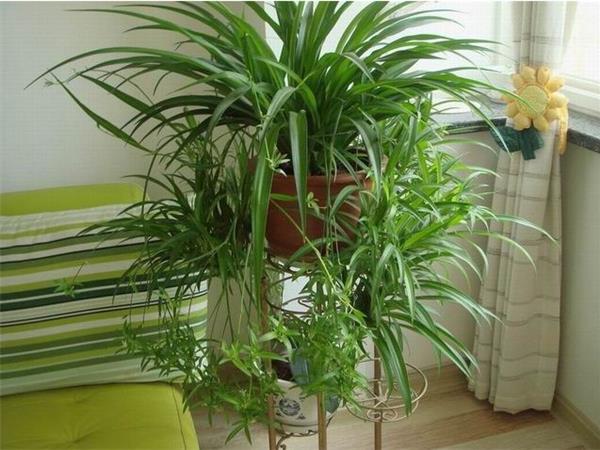List of indoor plants that can purify the air
Almost all indoor ornamental plants have the effect of purifying the air, green plants "green" a word reflects not only the color of plants, but also reflects the role of this purification of air, but which plants purify indoor air more potent, suitable for the newly renovated room? There are also rankings.
1st place spider orchid:
Chlorophytum in weak light can also carry out photosynthesis to produce oxygen, the ability to absorb toxic gases is also very strong. A pot of spider plants in 8 to 10 square meters of room equivalent to an air purifier, because spider plants can absorb 95% of carbon monoxide and 85% of formaldehyde in the air. It can also decompose benzene, absorb styrene, nicotine in cigarette smoke and other relatively stable harmful substances.

Second place Tiger Tail Orchid:
Sanse-tailed orchids, including monophyllum and other large-leaf ornamental plants, are natural scavengers.
A pot of tiger tail orchid can absorb more than 80% of harmful gases in a room of about 10 square meters, and two pots of tiger tail orchid can basically purify the air in the general room completely. Tiger tail orchid can also release a lot of oxygen during the day.
Third place aloe vera:
As an air purifier expert, a pot of aloe vera is equivalent to nine biological air cleaners.
This pot of aloe vera can absorb harmful gases such as carbon dioxide, sulfur dioxide, formaldehyde and carbon monoxide in the air, especially for formaldehyde.
Under the condition of 24 hours of illumination, a pot of aloe vera can eliminate 90% of formaldehyde contained in 1 cubic meter of air, kill harmful microorganisms in the air, and adsorb dust, which has a great effect on purifying the living environment.
In addition, it is also an indicator of air quality: when the concentration of harmful substances in indoor air is too high, the leaves of aloe will appear spots, which is a distress signal, reminding us to add a few pots of aloe indoors to strengthen the efforts to improve indoor air quality.
Fourth Ivy:
A pot of ivy can eliminate 90% of benzene in an 8-to 10-square-meter room, deal with bacteria and other harmful substances brought back from the outside, and even absorb dust that is difficult to vacuum.

Fifth place:
In a room of about 10 square meters, 70% of benzene, 50% of formaldehyde and 24% of trichloroethylene can be eliminated.
The sixth rose:
It can absorb hydrogen sulfide, hydrogen fluoride, benzene, ethyl phenol, ether and other gases; sulfur dioxide, nitrogen dioxide also has considerable resistance.
Other plants that purify the air include:
Cactus: Its characteristic is to close stomata during the day to prevent evaporation of water. Opening pores at night, absorbing carbon dioxide and releasing oxygen. If two or three pots of cactus are placed indoors, negative ions in the air can be increased, which is greatly conducive to sleep and health.

Silver Queen: Known for its unique ability to purify air: the higher the concentration of pollutants in the air, the more it can play its purification ability! It is therefore ideal for dark rooms with poor ventilation.
Clivia: Clivia can also photosynthesize in extremely weak light, and its carbon dioxide emitted by respiration at night is almost negligible. An adult Clivia, a day and night can absorb 1 liter of air, release 80% of oxygen, in a dozen square meters of indoor two or three pots of Clivia can absorb indoor smoke.
Rubber tree: rubber tree is a versatile way to eliminate harmful air, carbon monoxide, carbon dioxide, hydrogen fluoride and other harmful gases in the air have a certain absorption. In addition, it can eliminate inhalable particulate matter pollution and effectively stagnate indoor dust.

These are the common indoor plants that purify the air. Are there any favorite ones among them? If you like it but haven't cultivated it yet, take this opportunity to cultivate a pot.
Related
- Wuhan Hospital Iron Tree Blooming Result Was Instantly Frightened by the Gardener Master
- Which variety of camellia is the most fragrant and best? Which one do you like best?
- What is the small blue coat, the breeding methods and matters needing attention of the succulent plant
- Dormancy time and maintenance management of succulent plants during dormancy
- Minas succulent how to raise, Minas succulent plant pictures
- What are the varieties of winter succulent plants
- How to raise succulent plants in twelve rolls? let's take a look at some experience of breeding twelve rolls.
- Attention should be paid to water control for succulent plants during dormant period (winter and summer)
- Watering experience of twelve rolls of succulent plants
- Techniques for fertilizing succulent plants. An article will let you know how to fertilize succulent plants.



